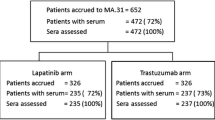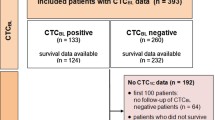Abstract
One hundred and twenty-two patients in whom the CA 15-3 level showed either a decline (92 patients) or an acute surge followed by a decline (30 patients) after chemotherapy were included. The clinical characteristics between the two groups and the CA 15-3 kinetics using receiver operating characteristic curves were analyzed. Patients with a surge had a significantly higher risk of disease progression than patients without a surge (P = 0.004; odds ratio 2.62; 95% CI 1.45–4.72). The clinicopathologic characteristics were significantly different between the two groups with respect to the distribution of ER, PR, and HER2 status, relapse-free survival, and the severity and extent of the involved organs. For patients with a surge, a CA 15-3 slope threshold > −0.0038 was chosen with a sensitivity of 80.0% and a specificity of 80.4%. The area under the curve was 0.847 (95% CI 0.771–0.906; P = 0.0001). A significant correlation between PFS and CA 15-3 slope was shown with Cox-regression modeling (P = 0.036; hazard ratio [HR], 2.1; 95% CI 1.01–4.14).These kinetics may serve as a good predictive marker of treatment response and response duration.




Similar content being viewed by others
References
Jager W, Kramer S, Palapelas V et al (1995) Breast cancer and clinical utility of CA 15-3 and CEA. Scand J Clin Lab Invest Suppl 221:87–92
Molina R, Zanon G, Filella X et al (1995) Use of serial carcinoembryonic antigen and CA 15.3 assays in detecting relapses in breast cancer patients. Breast Cancer Res Treat 36:41–48
Geraghty JG, Coveney EC, Sherry F et al (1992) CA 15-3 in patients with locoregional and metastatic breast carcinoma. Cancer 70:2831–2834
Rasmussen BB, Hilgers J, Hilkens J et al (1984) The influence of formalin and paraffin embedding on the immunohistochemical reaction of monoclonal antibodies applied to female breast tissue. Acta Pathol Microbiol Immunol Scand [A] 92:167–175
Berruti A, Tampellini M, Torta M et al (1994) Prognostic value in predicting overall survival of two mucinous markers: CA 15-3 and CA 125 in breast cancer patients at first relapse of disease. Eur J Cancer 30A:2082–2084
Klee GG, Schreiber WE (2004) MUC1 Gene-derived glycoprotein assays for monitoring breast cancer (CA15-3, CA 27.29, BR). Arch Pathol Lab Med 128:1131–1135
Gion M, Lione R, Leon AE et al (2001) CA27.29: a valuable marker for breast cancer management. A confirmatory multicentric study on 603 cases. Eur J Cancer 37:355–363
Lüfter D, Richter A, Günther S et al (2000) A comparison of bone-related biomarkers and CA27.29 to assess responser to treatment of osseous metastatic breast cancer. Anticancer Res 20:5099–5105
Brooks M et al (2009) Breast cancer screening and biomarkers. Methods Mol Biol 472:307–321
Lauro S, Trasatti L, Bordin F et al (1999) Comparison of CEA, MCA, CA 15-3 and CA 27-29 in follow-up and monitoring therapeutic response in breast cancer patients. Anticancer Res 19:3511–3515
Loprinzi CL, Tormey DC, Rasmussen P et al (1986) Prospective evaluation of carcinoembryonic antigen levels and alternating chemotherapeutic regimens in metastatic breast cancer. J Clin Oncol 4:46–56
Pons-Anicet DM, Krebs BP, Mira R et al (1987) Value of CA 15:3 in the follow-up of breast cancer patients. Br J Cancer 55:567–569
Tondini C, Hayes DF, Gelman R et al (1988) Comparison of CA 15-3 and carcinoembryonic antigen in monitoring the clinical course of patients with metastatic breast cancer. Cancer Res 48:4107–4112
Harris L, Fritsche H, Mennel R et al (2007) American society of clinical oncology 2007 update of recommendations for the use of tumor markers in breast cancer. J Clin Oncol 25:5287–5312
Therasse P, Arbuck SG, Eisenhauer EA et al (2000) New guidelines to evaluate the response to treatment in solid tumors. European Organization for Research and Treatment of Cancer, National Cancer Institute of the United States, National Cancer Institute of Canada. J Natl Cancer Inst 92:205–216
McShane LM (2005) Reporting recommendations for tumor marker prognostic studies. J Clin Oncol 23:9067–9072
McShane LM, Altman DG, Sauerbrei W et al (2006) REporting recommendations for tumor MARKer prognostic studies (REMARK). Breast Cancer Res Treat 100:229–235
Ohtsukasa S, Okabe S, Yamashita H et al (2003) Increased expression of CEA and MHC class I in colorectal cancer cell lines exposed to chemotherapy drugs. J Cancer Res Clin Oncol 129:719–726
Toth CA, Thomas P (1990) The effect of interferon treatment on 14 human colorectal cancer cell lines: growth and carcinoembryonic antigen secretion in vitro. J Interferon Res 10:579–588
Sorbye H, Dahl O (2004) Transient CEA increase at start of oxaliplatin combination therapy for metastatic colorectal cancer. Acta Oncol 43:495–498
Ailawadhi S, Sunga A, Rajput A et al (2006) Chemotherapy-induced carcinoembryonic antigen surge in patients with metastatic colorectal cancer. Oncology 70:49–53
Sorbye H, Dahl O (2003) Carcinoembryonic antigen surge in metastatic colorectal cancer patients responding to oxaliplatin combination chemotherapy: implications for tumor marker monitoring and guidelines. J Clin Oncol 21:4466–4467
Tampellini M, Berruti A, Gerbino A et al (1997) Relationship between CA 15-3 serum levels and disease extent in predicting overall survival of breast cancer patients with newly diagnosed metastatic disease. Br J Cancer 75:698–702
Fehm T, Jäger W, Krämer S et al (2004) Prognostic significance of serum HER2 and CA 15-3 at the time of diagnosis of metastatic breast cancer. Anticancer Res 24:1987–1992
van der Vegt B, de Roos MAJ, Peterse JL et al (2007) The expression pattern of MUC1 (EMA) is related to tumour characteristics and clinical outcome of invasive ductal breast carcinoma. Histopathology 51:322–335
de Roos MAJ, van der Vegt B, Peterse JL et al (2007) The expression pattern of MUC1 (EMA) is related to tumour characteristics and clinical outcome in ‘pure’ ductal carcinoma in situ. Histopathology 51:227–238
Iwanicki-Caron I, Fiore FD, Roque I et al (2008) Usefulness of the serum carcinoembryonic antigen kinetic for chemotherapy monitoring in patients with unresectable metastasis of colorectal cancer. J Clin Oncol 26:3681–3686
Author information
Authors and Affiliations
Corresponding author
Rights and permissions
About this article
Cite this article
Kim, H.S., Park, Y.H., Park, M.J. et al. Clinical significance of a serum CA15-3 surge and the usefulness of CA15-3 kinetics in monitoring chemotherapy response in patients with metastatic breast cancer. Breast Cancer Res Treat 118, 89–97 (2009). https://doi.org/10.1007/s10549-009-0377-2
Received:
Accepted:
Published:
Issue Date:
DOI: https://doi.org/10.1007/s10549-009-0377-2




